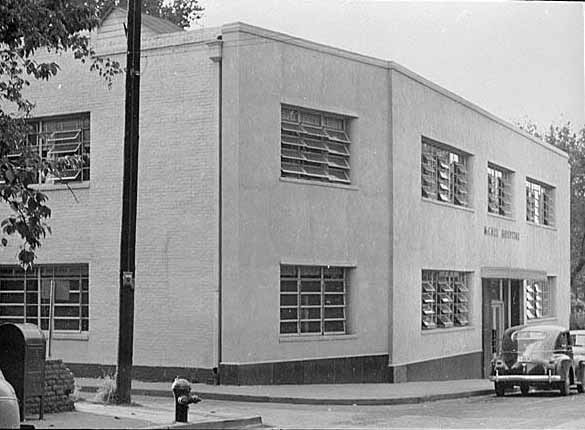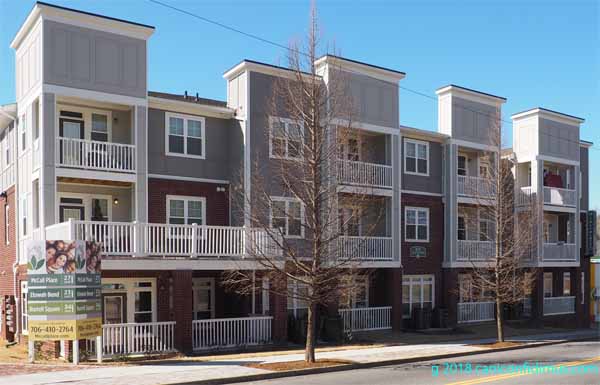One day in May 1950, my father and my brother Henry drove to McCall Hospital a few blocks from downtown Rome to pick up my mother and me. McCall Hospital was where I had made my first appearance on Planet Earth on the 18th. I don’t remember that day, but Henry does.
Henry was not quite three years old on that day. He says he remembers an image of the hospital, like a snapshot. Kind of like this:

Image from the Georgia Archives at the University of Georgia
This was McCall Hospital near that far, distant point in the past, probably a few years before my debut. My family took me home to a house on Redmond Road on that day. Maybe they stopped by my grandmother’s house on the way home.
McCall hospital was founded about a hundred years ago. I was born there. So was Leah. It operated as a hospital until around 1977, when the Hospital Corporation of America bought it, and then closed it the next year. The building was sold and operated as a boys’ home until 1986. It was sold again and operated as apartments, changing ownership several times until around 2010. It was then sold to the city (purchase price: $69,300, demolition cost bringing total expenditure to $290,000). This is what it looks like now.

Now it’s apartments
It’s a nice building, but it’s not McCall Hospital. That building was demolished. The hospital where I was born is gone now. So is the house my family took me home to, and my grandmother’s house. So are my mother and father. And now, the only person I know who actually remembers all of those places is making a slow goodbye to all that, and to all of us, too.
As I mentioned when I first mentioned my brother’s pancreatic cancer, I feel that I am betraying my brother when I say something like that. But those are the facts, and, as that great philosopher Joe Friday said, all we want are the facts, ma’am.
I went up to Chattanooga where Henry and his wife live on Monday of last week to help him prune some crepe myrtles growing up into the utility lines in front of their house. Henry wasn’t sure at first he would need my help, but after a few minutes of trying to hold an extension pruning saw up over his head, he said maybe he could point and I could cut.
So we worked for a while, and then Henry told me he was going to see his wife’s son Keith at Keith’s studio. Keith is a videographer. Keith and I had essentially the same thought at the same time. When Henry told me of his diagnosis, I said he should start writing his biography. I said that his two sons would appreciate it, just like we would have appreciated it if our father had written about his life. And, I said, if his sons ever have children, they will never know their grandfather, except through something like that. Keith said essentially the same thing, but since he’s a videographer, he wanted to video Henry talking about his life.
And so that’s what Henry did that afternoon, after we drove by McDonald’s so Henry could get a Big Mac. He said that one effect of his chemotherapy was that things that he used to like don’t taste good any more, but a Big Mac was OK.
Keith set up a stool in his studio and trained his video camera on Henry, and let Henry talk, prompting him every once in a while. I watched on a monitor in an adjoining room, only a few feet from Henry and Keith.
Watching and listening to Henry talk, about himself some, but mostly about the people in his life, was moving. We shared a lot of experiences, of course, and I knew most of what had happened to him after he left home for Georgia Tech, but these were Henry’s perceptions of the events, and they were just different enough from mine.
Henry and I were often confused for twins when we were kids, although we never thought we looked that much alike. I have heard of twins who were separated at birth but who did things and made choices that were almost identical over the years. Henry and I were a little bit like that. We have both had facial hair almost since we were able to grow it. Over the years we went from full beards to shaved faces, back to beards, then to goatee and moustache. It seemed like every time I changed my facial hair, I found out that Henry had done much the same at close to the same time. We also seem to think a lot alike, and of the same things at close to the same times. Henry’s older son Thomas had to put his dog Cooper down last week. I texted Henry to get an email address so Leah and I could send our condolences to him. He texted it to me. The next day when I was walking our dogs, I started thinking about Thomas and Cooper and almost immediately Henry texted me to make sure I had Thomas’s email.
I have followed in Henry’s footsteps almost my entire life, never quite making it like he did. He went to Georgia Tech the summer after he graduated from high school. Ten years later he had a PhD. Three years after him, I graduated from high school and followed him to Tech, but within a week I knew it was not for me. Not until 12 years later did I finally go back to grad school at Tech and fool enough people to get my own PhD.
Henry ended up working in the defense industry. Even with a degree in a much different field from Henry, I ended up in the defense industry, too.
Henry went down to the Gulf Coast on his vacation to help people whose homes were damaged or destroyed by Hurricane Katrina. The experiences he had down there convinced him to quit his job and go to work full-time with Presbyterian Disaster Assistance. He told Keith and me he found that the people he went down to help were actually helping him, too. And that experience convinced him to enter seminary school. He said it was the first time he had ever simply jumped without knowing exactly where he would land.
I with I could have been there at the seminary to see his instructors dealing with a PhD scientist older than most of them and probably knowing a hell of a lot more than they did. And Henry can be kind of prickly on occasion. I suppose that’s another trait we share.
After seminary school, Henry ended up at a very small church in Spring City, Tn, with a group of parishioners who had split from their old church over admission of gay people to the ministry. They, like Henry, were on the right side of that issue. Henry helped the congregation grow, and grow close to each other. He said they are like family.
Henry texted us Thursday to let us know the results of his latest CT scan, the one that we hoped would show shrinkage of the tumors in his liver due to the chemo. It did not. He said he has felt some minor, infrequent pain and is more fatigued than normal. He and his doctor have identified three clinical trials in the Chattanooga area that he would probably qualify for.
It’s possible that one of the new treatments being tested will give Henry some additional time. We look for something to hope for, so we hope for that.
It’s human nature to ask why something like this happens to someone like Henry. We ask the question, but I’m afraid there is no answer. Maybe Henry thinks there is an answer, possibly unknowable to us. He does, after all, still have his faith.
Unfortunately for me, I suppose, that’s one place I could never follow him.